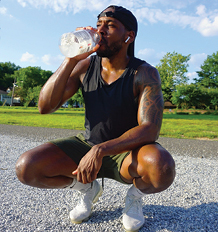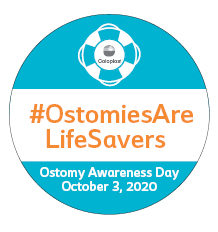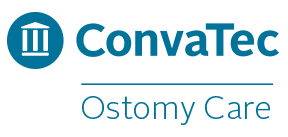A research study about the benefits of perioperative self-management support for ostomates
Ostomates are not only dealing with intestinal concerns but are also at risk for a multitude of complications. Data shows that 38% of ostomy patients find themselves back in the emergency room or  being admitted within the first 90 days post operatively [1]. This is one of the highest rates of readmission when compared to other types of surgery. The most common cause for re-admission is dehydration, at approximately 40% of post ileostomy readmissions [2]. We also know that 84% of ostomy patients develop skin issues. The causes of these can be chemical, mechanical, or microbial, and possibly avoidable. Ostomates also have significantly increased healthcare costs, especially when affected by peristomal skin complications, and leakage [2]. It is known that 25% of ostomates develop renal failure within two years. The complications these patients encounter require 7x more outpatient visits than the average patient. And 29.1% of ostomates experience readmission which costs approximately $16,000 per patient [1]. These statistics show that specialized care for these patients is imperative to improving patient outcomes in this patient population.
being admitted within the first 90 days post operatively [1]. This is one of the highest rates of readmission when compared to other types of surgery. The most common cause for re-admission is dehydration, at approximately 40% of post ileostomy readmissions [2]. We also know that 84% of ostomy patients develop skin issues. The causes of these can be chemical, mechanical, or microbial, and possibly avoidable. Ostomates also have significantly increased healthcare costs, especially when affected by peristomal skin complications, and leakage [2]. It is known that 25% of ostomates develop renal failure within two years. The complications these patients encounter require 7x more outpatient visits than the average patient. And 29.1% of ostomates experience readmission which costs approximately $16,000 per patient [1]. These statistics show that specialized care for these patients is imperative to improving patient outcomes in this patient population.
A recent study published by the American Society of Colon and Rectal Surgeons shows how one company, 11 Health and Technologies, is utilizing a novel care approach to improve the quality of life and outcomes in this type of patient. The company developed alfred: SmartCare, a unique care model designed to meet the specialized need of ostomates. The program consists of a SmartBag and SmartWafer, mobile application, patient coaches (who were/are also ostomates, trained to support this type of patient) and the nursing team. The patient wears the SmartBag and SmartWafer, which submits data to the mobile application and clinical dashboard. The data is visible to the patient, their coach, the nursing team and the patient’s clinicians to be used to identify trends and abnormalities in the values. The patient can see how much output they have expressed and what the temperature is of their peristomal skin. These data points can help to curtail oncoming hydration issues or infections. When abnormalities are identified, the coach can work with the patient to provide education and can escalate issues to the nursing team for medical guidance.
In the study, the outcomes of 66 new ostomates from 19 different states were monitored for the first 30 post-operative days. The study showed that close monitoring of ostomy output volume as well as perioperative self-management support can significantly reduce the rate of hospital readmissions in the first 30 days after ostomy surgery.
Patients and healthcare providers should be open to the use of innovative programs that use remote monitoring along with telehealth, as they can be beneficial in improving the outcomes of patients in the immediate post-operative period.
To read the full study, visit the Diseases of the Colon & Rectum online at: https://journals.lww.com/dcrjournal/Citation/2020/12000/Improved_30_Day_Surgical_Outcomes_in_Ostomates.17.aspx
Editor’s note: This article is from one of our digital sponsors, 11 Health and Technologies. Sponsor support along with donations from readers like you help to maintain our website and the free trusted resources of UOAA, a 501(c)(3) nonprofit organization.
[1] Tyler, J. A., Fox, J.P., Dharmarajan, S., Silviera, M. L., Hunt, S. R., Wise, P. E., Mutch, M. G. (2014). Acute health care resource utilization for ileostomy patients is higher than expected. Diseases of the Colon & Rectum, 57(12), 1412-1420.
[2] Justiniano, C. F., Temple, L. K., Swanger, A. A., Xu, Z., Speranza, J. R., Cellini, C., Salloum, R. M., & Fleming, F. J. (2018). Readmissions With Dehydration After Ileostomy Creation: Rethinking Risk Factors. Diseases of the colon and rectum, 61(11), 1297–1305. https://doi.org/10.1097/DCR.0000000000001137
[3] Taneja, C., Netsch, D., Rolstad, B. S., Inglese, G., Eaves, D., Oster, G (2019). Risk and economic burden of peristomal skin complaints following ostomy surgery. Journal of Wound, Ostomy and Continence Nursing, 46(2), 143-149.
[4] Fearn, Robert I. M.D., M.R.C.P.1,2; Gorgun, Emre M.D.3; Sapci, Ipek M.D.3; Mehta, Saahil N. M.D.2; Dinh, Binh B.S.2; Yowell, Quinn V. M.S.2; Eisenstein, Samuel M.D.4 (2020). Improved 30-Day Surgical Outcomes in Ostomates Using a Remote Monitoring and Care Management Program: An Observational Study. Diseases of the Colon & Rectum: December 2020 – Volume 63 – Issue 12 – p e581-e586.




 life. When the doctors first told me that the best option was to have ileostomy surgery, I was so upset but I was in so much pain I was hoping that it would make me feel better. When I finally woke up from surgery and realized I had an ileostomy – I cried. I didn’t even want to look at it. It took some time, but I got used to it, my stoma saved my life.
life. When the doctors first told me that the best option was to have ileostomy surgery, I was so upset but I was in so much pain I was hoping that it would make me feel better. When I finally woke up from surgery and realized I had an ileostomy – I cried. I didn’t even want to look at it. It took some time, but I got used to it, my stoma saved my life. Having an ostomy should not hold you back from participating in the run/walk. Our Coloplast® Care team is here to support you if you want to chat, just give us a call at 1-877-858-2656. We also have
Having an ostomy should not hold you back from participating in the run/walk. Our Coloplast® Care team is here to support you if you want to chat, just give us a call at 1-877-858-2656. We also have  My journey with Short Bowel Syndrome (SBS) spans 61 years, and it has been full of twists and turns. I’ve often wished that I understood from the beginning exactly what it meant to have SBS – it is not temporary, rather it is chronic. That means it’s a lifelong condition, and it has frequently caused me to make adjustments to maintain my independence and lead a productive and meaningful life. Reaching independence and self-reliance took years of learning the importance of self-advocacy to get the information I needed from my healthcare providers, no matter how difficult it may have been to hear that information. Each symptom, diagnosis, ostomy and medical procedure that preceded my eventual SBS diagnosis posed new challenges. The more I knew about what lay ahead for me, the more I could take charge of my own life. As August marks SBS Awareness Month, I hope my experiences will help inform and inspire others living with this serious and chronic malabsorption disorder to speak up and ask for information and tips to help maintain as much independence as possible.
My journey with Short Bowel Syndrome (SBS) spans 61 years, and it has been full of twists and turns. I’ve often wished that I understood from the beginning exactly what it meant to have SBS – it is not temporary, rather it is chronic. That means it’s a lifelong condition, and it has frequently caused me to make adjustments to maintain my independence and lead a productive and meaningful life. Reaching independence and self-reliance took years of learning the importance of self-advocacy to get the information I needed from my healthcare providers, no matter how difficult it may have been to hear that information. Each symptom, diagnosis, ostomy and medical procedure that preceded my eventual SBS diagnosis posed new challenges. The more I knew about what lay ahead for me, the more I could take charge of my own life. As August marks SBS Awareness Month, I hope my experiences will help inform and inspire others living with this serious and chronic malabsorption disorder to speak up and ask for information and tips to help maintain as much independence as possible. Six years later, I found myself unable to eat due to severe abdominal pains and a pseudo-obstruction and was put back on TPN. I feared this would prevent me from traveling on a three-week family trip to Australia, but my husband and daughters learned how to properly store, prepare and administer my TPN infusions, so we could still travel. I am so grateful to have been able to enjoy that trip with my family despite my TPN, ostomy and needing to use a catheter.
Six years later, I found myself unable to eat due to severe abdominal pains and a pseudo-obstruction and was put back on TPN. I feared this would prevent me from traveling on a three-week family trip to Australia, but my husband and daughters learned how to properly store, prepare and administer my TPN infusions, so we could still travel. I am so grateful to have been able to enjoy that trip with my family despite my TPN, ostomy and needing to use a catheter. 


